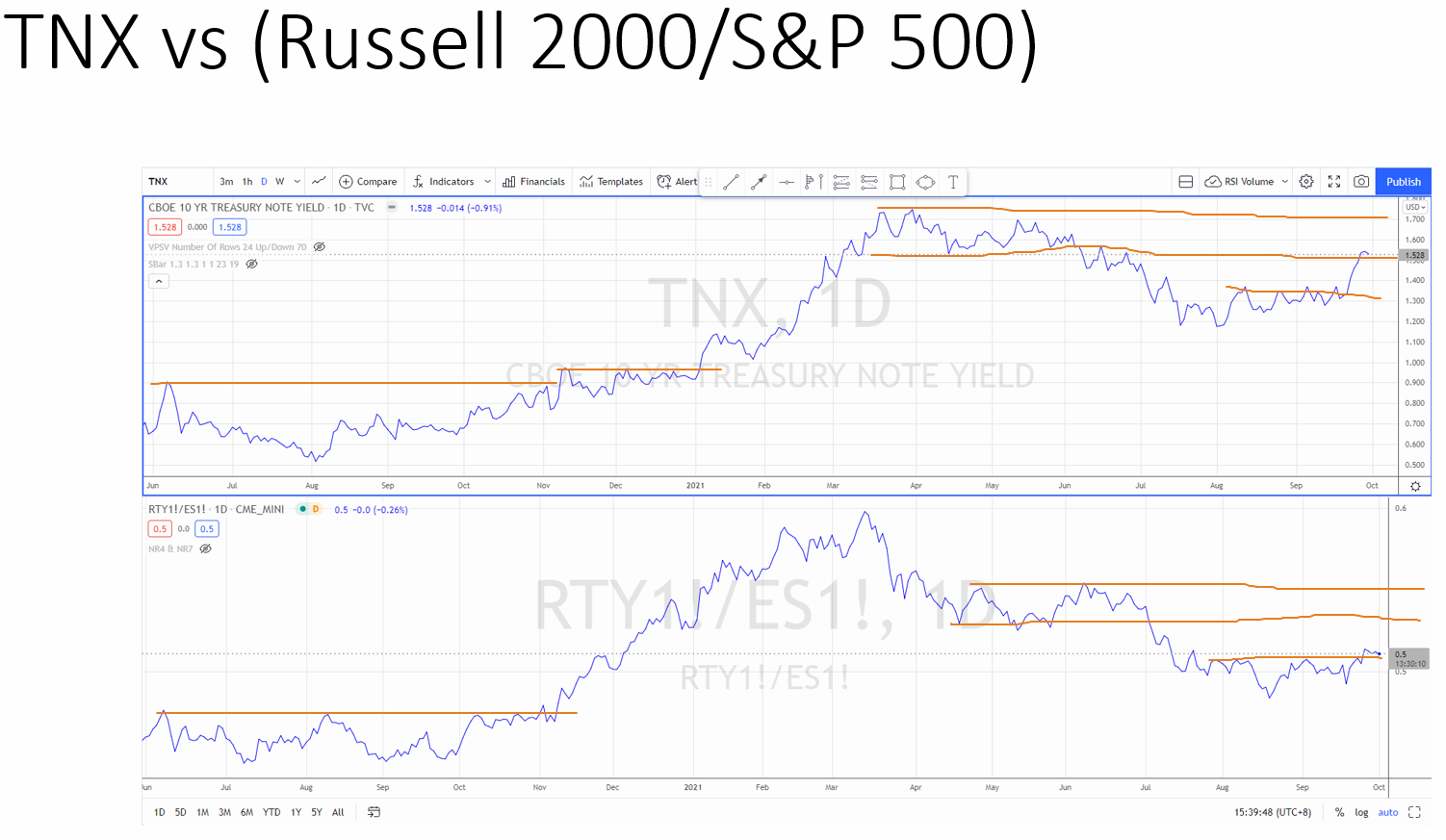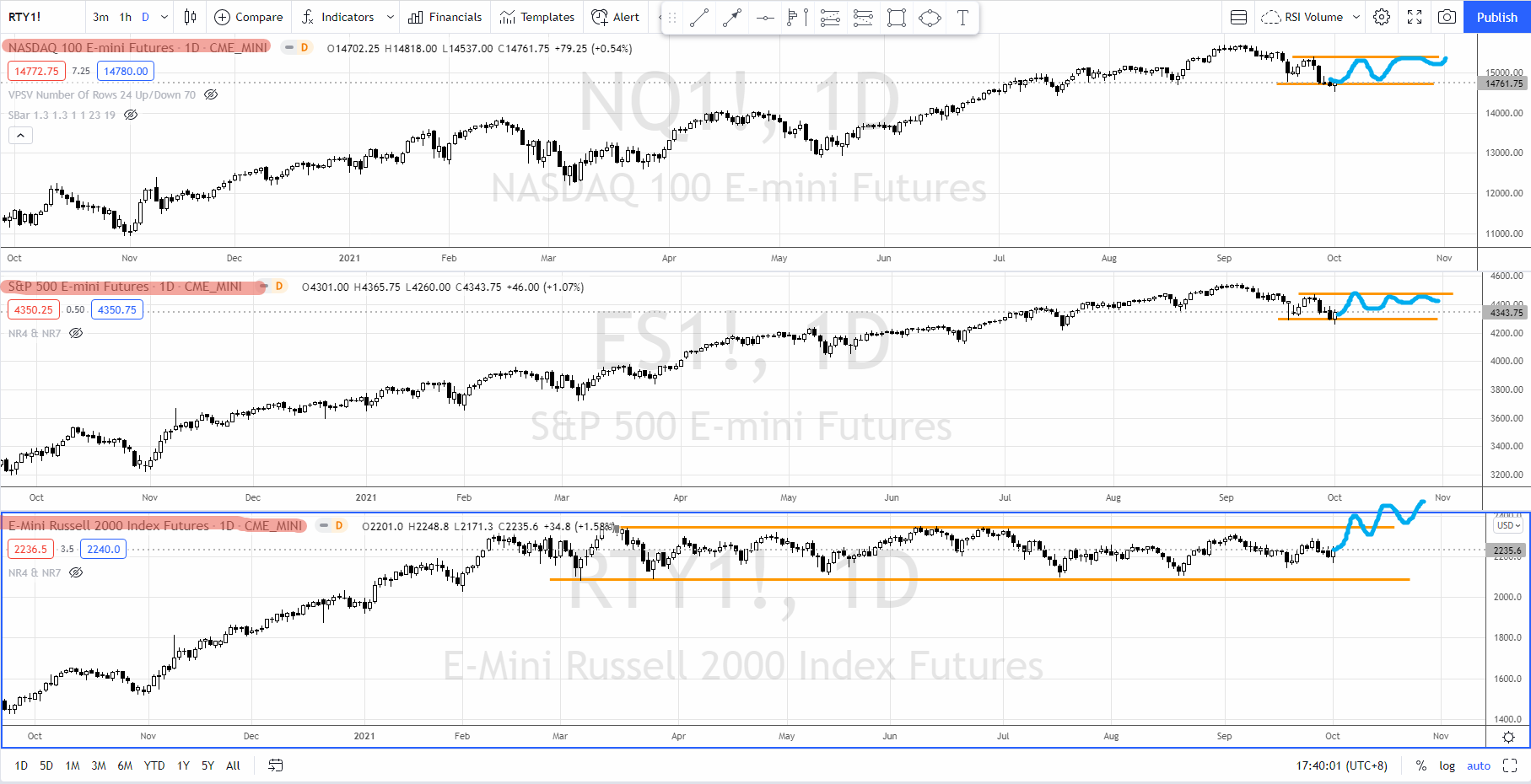Despite all the 4 major US indices dropped in the past one week, Russell 2000 was the strongest among the 4, where it only dropped -0.37% while Nasdaq 100 dropped 3.6%, S&P 500 dropped 2.3% and the Dow Jones dropped 1.5%.
This simply shows outperformance of the small-cap stocks (Russell 2000) over the other indices.
Below is the most interesting chart for last week since the sharp rising interest rate (as shown in the upper pane) triggered more weakness for the market, especially the Nasdaq 100 and the S&P 500.

After a spectacular run up of the 10 year treasury yield (TNX) from 1–1.7 in Jan-Mar 2021, it slowly came down to consolidate between 1.2–1.3 and last week had a breakout from the Wyckoff accumulation range and spiked to 1.5.
The chart above compares the 10 year treasury yield (TNX) with the ratio chart (Russell 2000/S&P 500).
How to read the ratio chart (Russell 2000 / S&P 500)
The ratio chart (Russell 2000/S&P 500) compares the 2 indices. During a rising trend, Russell 2000 outperforms S&P 500 and vice versa. The ratio chart works in both bullish and bearish market.
In a bullish market, the outperformance means Russell 2000 rises more than the S&P 500 while in a bearish market (where both indices are in a correction and falling) the outperformance could mean Russell 2000 drops less than the S&P 500.
Relationship between 10 year yield and the ratio chart
Back to the chart above, we can notice that since at least a year ago, while the 10-year yield is trending up, the ratio chart (Russell 2000/S&P 500) is also trending up. This is especially obvious from Nov 2020 till Mar 2021.
This means when the interest rate is rising, there is a rotation from S&P 500 into the Russell 2000 hence the Russell 2000 outperforms the S&P 500 because the smart money took profit from the big/mega cap stocks and rotated into the small-cap stocks where a lot of them are undervalued and/or underperformed.
Since Mar 2021, the 10-year yield has been gradually coming down while the ratio chart (Russell 2000/S&P 500) is trending down too.
This means that when the interest rate is coming down, the S&P 500 starts to outperform the Russell 2000 because the smart money took profit from the small-cap stocks (after a significant run up) and rotated back into the big/mega cap stocks.
This is the short version of how the rotation is played out. Of course, within the index (no matter the Russell 2000, or S&P 500), there will be sector/industry group rotations going on from time to time.
What’s happening now?
As the 10-year yield is rising, we are witnessing an on-going rotation from the big/mega cap (including Nasdaq 100) into the small cap stocks (Russell 2000). Russell 2000 has showed outperformance since Aug 2021.
I anticipate a potential trading range formed for S&P 500 and the Nasdaq 100 while Russell 2000 is to breakout of the existing range, as shown below:

So it is essential to analyze your portfolio and see if you need to adjust your holdings to exit those underperform and re-balance with the outperforming stocks so that you will always beat the market.
Of course portfolio re-balancing is highly dependent on your trading/investing strategies, holding duration and risk profile. Maybe time for a reflection?
Meanwhile check out the video below to find out why now could be the best time to invest in Silver:
Note: All information on this page is subject to change. The use of this website constitutes acceptance of our user agreement. Please read our privacy policy and legal disclaimer. Opinions expressed at FXstreet.com are those of the individual authors and do not necessarily represent the opinion of FXstreet.com or its management. Risk Disclosure: Trading foreign exchange on margin carries a high level of risk, and may not be suitable for all investors. The high degree of leverage can work against you as well as for you. Before deciding to invest in foreign exchange you should carefully consider your investment objectives, level of experience, and risk appetite. The possibility exists that you could sustain a loss of some or all of your initial investment and therefore you should not invest money that you cannot afford to lose. You should be aware of all the risks associated with foreign exchange trading, and seek advice from an independent financial advisor if you have any doubts.
Recommended Content
Editors’ Picks
EUR/USD fluctuates near 1.0700 after US data

EUR/USD stays in a consolidation phase at around 1.0700 in the American session on Wednesday. The data from the US showed a strong increase in Durable Goods Orders, supporting the USD and making it difficult for the pair to gain traction.
USD/JPY refreshes 34-year high, attacks 155.00 as intervention risks loom

USD/JPY is renewing a multi-decade high, closing in on 155.00. Traders turn cautious on heightened risks of Japan's FX intervention. Broad US Dollar rebound aids the upside in the major. US Durable Goods data are next on tap.
Gold stays in consolidation above $2,300

Gold finds it difficult to stage a rebound midweek following Monday's sharp decline but manages to hold above $2,300. The benchmark 10-year US Treasury bond yield stays in the green above 4.6% after US data, not allowing the pair to turn north.
Worldcoin looks set for comeback despite Nvidia’s 22% crash Premium

Worldcoin price is in a better position than last week's and shows signs of a potential comeback. This development occurs amid the sharp decline in the valuation of the popular GPU manufacturer Nvidia.
Three fundamentals for the week: US GDP, BoJ and the Fed's favorite inflation gauge stand out Premium

While it is hard to predict when geopolitical news erupts, the level of tension is lower – allowing for key data to have its say. This week's US figures are set to shape the Federal Reserve's decision next week – and the Bank of Japan may struggle to halt the Yen's deterioration.